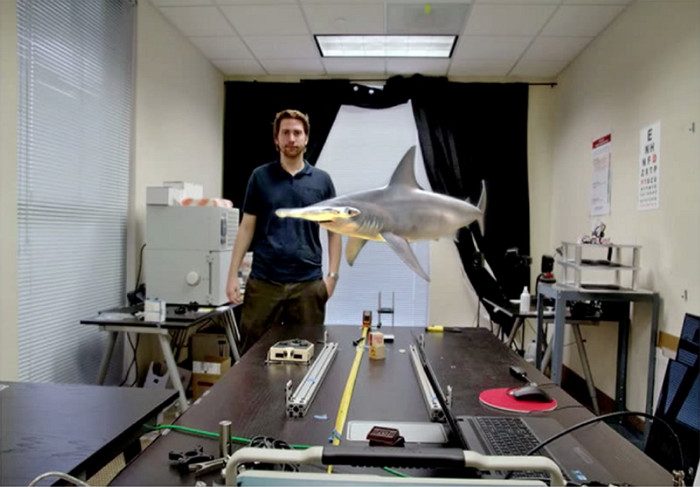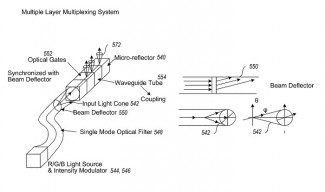Trademarks
Trademarks filed by Magic Leap (dug up by Reddit user Fastidiocy) confirm that the company is interested in light-field technology. In February, 2014, the company applied for a Trademark on the term ‘DDLS’. “Wearable computer hardware, namely, an optical display system incorporating a dynamic digital lightfield display,” reads the application.
Among the company’s 36 trademark applications are many references to comic books, specifically relating to what sounds like augmented reality functionality. “Comic books enhanced with specialized covers; graphic novels enhanced with specialized covers,” reads one of the applications.
“Imagine if the imagination could imagine” is probably the zaniest among the trademark applications, along with the company’s oft-used phrases, “Cinematic Reality,” “A Rocketship for the Mind,” and what sounds like an app store for their hardware called “The Magic Shop.”
Patents
The company has also applied for several patents relating to head mounted displays, virtual reality, and augmented reality. It’s here that we pick up significant hints about AR applications of the tech, especially with the discussion of a transparent display; “…the projection device being capable of assuming a substantially transparent state when no image is projected,” as one of the patent applications reads.
Here’s a sample of patents which may indicate what approach the company is taking to achieving its vision (dates are when the patent was filed).
March 14th, 2014 – Display System and Method
One embodiment is directed to a user display device comprising a housing frame mountable on the head of the user, a lens mountable on the housing frame and a projection sub system coupled to the housing frame to determine a location of appearance of a display object in a field of view of the user based at least in part on at least one of a detection of a head movement of the user and a prediction of a head movement of the user, and to project the display object to the user based on the determined location of appearance of the display object.
January 15th, 2014 – Ultra-high Resolution Scanning Fiber Display
One embodiment is directed to a compact system for scanning electromagnetic imaging radiation, comprising a first waveguide and a second waveguide, each of which is operatively coupled to at least one electromagnetic radiation source and configured such that output from the first and second waveguides is luminance modulated and scanned along one or more axes to form at least a portion of an image.
September 11th, 2013 – Ergonomic Head Mounted Display Device and Optical System
Optical systems such as image display systems include a freeform optical waveguide prism and a freeform compensation lens spaced therefrom by a gap of air or index cement. The compensation lens corrects for aberrations which the optical waveguide prism will introduce in light or images from an ambient real-world environment. The optical waveguide prism receives actively projected images at an entry location, and emits the projected images at an exit location after internally reflecting the images along an optical path therein. The image display system may include an image source and coupling optics. The approach permits design of an optical viewing device, for example in optical see-through HMDs, achieving an eyeglass-form appearance and a wide see-through field of view (FOV).
November 23rd, 2012 – Three Dimensional Virtual and Augmented Reality Display System:
A system may comprise a selectively transparent projection device for projecting an image toward an eye of a viewer from a projection device position in space relative to the eye of the viewer, the projection device being capable of assuming a substantially transparent state when no image is projected; an occlusion mask device coupled to the projection device and configured to selectively block light traveling toward the eye from one or more positions opposite of the projection device from the eye of the viewer in an occluding pattern correlated with the image projected by the projection device; and a zone plate diffraction patterning device interposed between the eye of the viewer and the projection device and configured to cause light from the projection device to pass through a diffraction pattern having a selectable geometry as it travels to the eye.
October 29th, 2012 – System and Method for Augmented and Virtual Reality
One embodiment is directed to a system for enabling two or more users to interact within a virtual world comprising virtual world data, comprising a computer network comprising one or more computing devices, the one or more computing devices comprising memory, processing circuitry, and software stored at least in part in the memory and executable by the processing circuitry to process at least a portion of the virtual world data; wherein at least a first portion of the virtual world data originates from a first user virtual world local to a first user, and wherein the computer network is operable to transmit the first portion to a user device for presentation to a second user, such that the second user may experience the first portion from the location of the second user, such that aspects of the first user virtual world are effectively passed to the second user.
October 1st, 2012 – Tactile Glove for Human-computer Interaction
One embodiment is directed to a system for human-computer interface, comprising an input device configured to provide two or more dimensions of operational input to a processor based at least in part upon a rubbing contact pattern between two or more digits of the same human hand that is interpreted by the input device. The input device may be configured to provide two orthogonal dimensions of operational input pertinent to a three-dimensional virtual environment presented, at least in part, by the processor. The input device may be configured to detect the rubbing between a specific digit in a pen-like function against one or more other digits. The input device further may be configured to detect the rubbing between the specific digit in a pen-like function and one or more other digits in a receiving panel function.
May 7th, 2012 – Massive Simultaneous Remote Digital Presence World
Various methods and apparatus are described herein for enabling one or more users to interface with virtual or augmented reality environments. An example system includes a computing network having computer servers interconnected through high bandwidth interfaces to gateways for processing data and/or for enabling communication of data between the servers and one or more local user interface devices. The servers include memory, processing circuitry, and software for designing and/or controlling virtual worlds, as well as for storing and processing user data and data provided by other components of the system. One or more virtual worlds may be presented to a user through a user device for the user to experience and interact. A large number of users may each use a device to simultaneously interface with one or more digital worlds by using the device to observe and interact with each other and with objects produced within the digital worlds.
We’ve reached out to Magic Leap leap for comment, but unsurprisingly they did not provide anything substantive. We’ll be continuing to watch Magic Leap closely.
Should we believe the hype?







